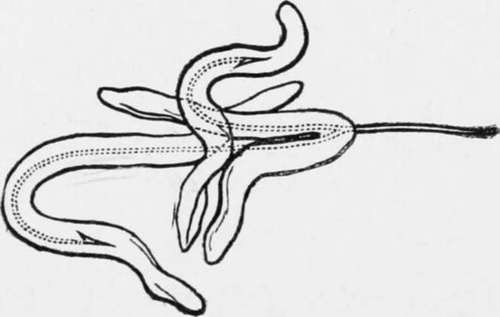Section VII. Bottom-Water And Bait Fishing
Description
This section is from the book "American Game Fishes", by W. A. Perry. Also available from Amazon: American Game Fishes: Their Habits, Habitat, and Peculiarities; How, When, and Where to Angle for Them.
Section VII. Bottom-Water And Bait Fishing
Very little so-called "bottom-fishing" is practiced in this country, but it seems likely that the Bull-head, Sucker, Eel, and several other useful fishes, might be more readily made to render sport, if a little more attention were paid to their methods of capture.
Take for example the Bull-head: There is a right and a wrong way of putting on the worm for this fish. It should be threaded right up the center, though I am aware that when they are freely biting it matters little how the bait is affixed. For bait-fishing for Trout, the best tackle is that shown at fig. 55, and the way to adjust the wriggling worm is as shown in fig. 56.
Ordinarily, the best sinker is a round shot; but in the case of fishing in a swift stream, the leaden sinker shown at fig. 57 is far superior. When a fish bites it draws the line in the direction of the arrow, and the fisherman at the opposing end feels it instantly, and strikes. Sucker-fishing with the succulent worm and fine tackle is far from ignoble sport, at the proper season of the year.

Fig. 55.

Fig. 56.
Bottom-fishing is much practiced in Europe, where fish of the ground-feeding kind are more frequently met with than is the case here. Still, there are times when the stationary sunk worm will take Bass, and nothing else will- this is also the case with the Trout (5. Salvelinus).
The newly acclimatized Carp may be caught by still-bottom-fishing, but a previous ground-baiting is necessary. The bait-either a paste of cheese, or worm, should be allowed to rest on the ground, and the wily fish will then, if the tackle be fine, avail themselves of it. They are "kittle-cattle," however, to capture.
I have thus briefly and succinctly sketched the lesser tackling of the angler, and the methods of making. The matter of rods is a very serious one, and demands a separate chapter, which is accorded it. The two subjects are separated for the convenience of the reader, rather than because they are necessarily of distinct nature. Any and all anglers can learn to make their flies, leaders, etc., but to make rods requires closer attention, and is really a trade in itself.

Fig- 57.
Continue to:
- prev: Section VI. Tackle For Mid-Water Fishing. Continued
- Table of Contents
- next: The Fishing-Rod, And Its Amateur Manufacture
